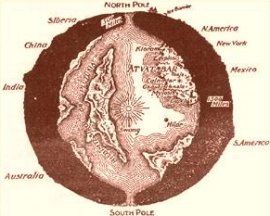Here are five other obsolete theories once commonly accepted by mainstream science.
1. Emission Theory
How do we see? Our brains process the information held within visible light, which either issues directly from a source or is reflected off objects and "bounced" into our eyes. According to emission theory, our eyes aren't receiving these rays of light - they are emitting them. In short, we see by shooting "sight" beams from our eyes.
Emission theory was first proposed in the fifth century BCE and supported by the likes of renowned scholars Plato, Euclid and Ptolemy. However, there was always a school of thought that opposed this notion and supported ideas more in line with our modern understanding of vision - though that understanding may not be as widespread as the education system would hope. A study conducted in 2002 found that as many as 50% of American college students believe human vision operates on principles in line with emission theory.
Curiously, ray tracing technology in computer graphics is a technique that generates images in a manner very similar to emission theory, by tracing a straight-line path from the camera (or eye) to the objects in front of it and gathering the information needed to construct a picture.
2. Rain Follows the Plow
In the late 19th century, it was widely believed across Australia and the American West that human settlement induced rainfall. Yes, climatologists actually believed that the act of migrating to a region of wilderness and cultivating the soil there would increase the rainfall to that area. Want to turn a barren desert into lush farmland? No problem! Just farm it.
The "scientific" explanation for this theory was that, by plowing soil, you expose the soil's moisture to the sky. According to another hypothesis, vibrations in the air caused by human activity helped create more clouds, which led to widespread dynamiting of the sky across the Great Plains in the 1870s.
There is some truth behind this theory, however. Plants "sweat," or transpire, releasing water into the atmosphere. So by planting trees and growing crops, you will increase the rainfall to an area, but this effect is very limited in scope and generally comes at the expense of rainfall to a neighboring area.
3. Humorism
No, this isn't some theory of comedy. Humorism was a system of medicine that held that human health was controlled by the balance of four bodily fluids known as the "four humors" - blood, phlegm, yellow bile, and black bile. Ancient Greek and Roman physicians thought that having too much or too little of any of these fluids would negatively influence your well-being, and this theory was widely accepted in Western medicine until the nineteenth century - a span of over 2,000 years.
Remember the "medical" practice of bloodletting through cutting or the application of leeches? That was due to a belief that the body had too much blood relative to the other humors. If you were believed to have too much phlegm, your treatment was much more enjoyable: you may be served wine, a food associated with yellow bile, which counterbalances phlegm.
The theory of the four humors is closely associated with the classical elements, and in fact, each humor has an associated element: blood/air, phlegm/water, black bile/earth, and yellow bile/fire. This internal consistency no doubt lent the theory greater credibility.
4. Expanding Earth Theory
When it was discovered that South America fit so snugly into the nook of Africa, scientists puzzled over hypotheses that could explain the apparent continental drift. As of the 1970s, the prevailing theory is plate tectonics, but one popular theory before that was that the Earth was expanding, increasing in volume like a balloon being inflated.
While the notion may sound ridiculous to us today, it was first put forth by none other than Charles Darwin after observing raised beaches in Patagonia. It seemed to him that a huge area of South America had been raised upward, and he hypothesized that this was caused by the gradual expansion of the Earth. Since then, measurements and models have largely debunked any idea that our planet is growing in size, and the theory of plate tectonics offers better solutions to the puzzles that the expanding Earth theory was attempting to resolve.
A big problem that the expanding Earth theory faced was a plausible mechanism for the expansion - why would the Earth be growing? A modern supporter of an expanding Earth theory, interdisciplinary scientist J. Marvin Herndon believes that the Earth formed from a Jupiter-like planet that lost its gaseous atmosphere in a sudden and catastrophic event. The gas would have previously been exerting pressure on the planet, squeezing it, and with the gas removed, the Earth would then expand like a giant stress ball released from a tight grip.
Comment: Neal Adams makes a good argument that the earth actually is expanding. Check it out. We also know that the earth's rotation is slowing down incrementally which may lend credence to an expanding earth theory.
5. Hollow Earth Hypothesis
Ancient folklore and mythology across the world is filled with beliefs of subterranean realms deep below the Earth's surface, often strongly tied to religious ideas. But even scientists ascribed to various theories that called for a hollow Earth, including Edmond Halley - the man after whom Halley's Comet is named. In 1692, in an attempt to explain anomalous compass readings, Halley proposed that the Earth consisted of a hollow shell, some 500 miles thick, with inner shells that each had their own magnetic poles.
Variations of this idea were put forth by other scientists up and until the 20th century, when the study of seismic waves gave us the current picture we have of the interior of the Earth. A seismic wave is a wave of energy, often caused by an earthquake or explosion, that travels through the Earth. Using instruments, we're able to measure the properties of these waves, including how fast they travel through different materials. The denser the material, the more quickly the wave travels.
When traveling through air, seismic waves move at the speed of sound - Mach 1. Through water, they travel over four times as fast, and through a hard rock like granite, over 15 times as fast. Because we have observed the travel speeds of seismic waves through the Earth, we know that the only thing beneath our feet are layers of dense material, not large pockets of air or empty space. Sorry, Verne fans, but the only journey we're taking to the center of the Earth lies in the realm of fiction.








Trees act like a brush or comb, making riffles that the moisture and rain can get caught in. Clear-cutting forests removes the traps that cause the rainclouds to slow down where the twain meet.
According to David Archibald, experiments show that plants need less water when there is more CO2. So if you want to shrink deserts, the Earth needs more CO2 in it's atmosphere.